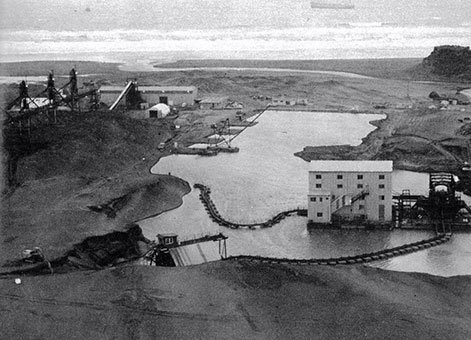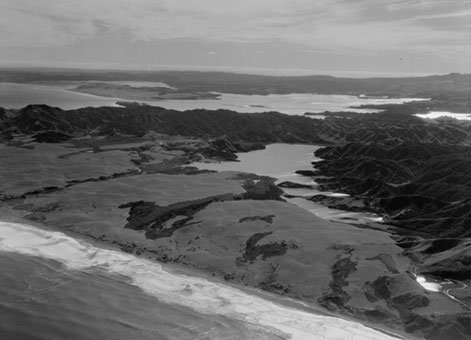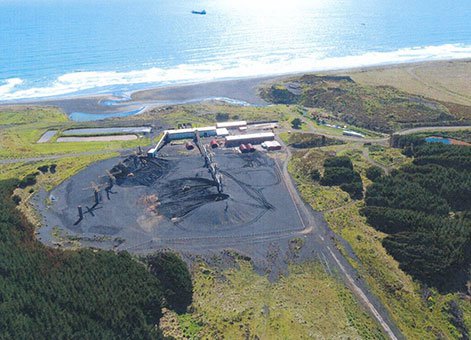The Taharoa ironsand mining project was commissioned in 1972 and has been a success story for the local community and New Zealand Steel Mining.

Taharoa ironsands mining, circa 1974. Cover image, New Zealand Engineering, Vol. 29:5 (May 1974).
Taharoa, an isolated and exposed location on the North Island’s west coast, has the largest deposits of ironsand (titanomagnetite) in New Zealand. There was an estimated 300 million tons of concentrate available when the mining project commenced.
Ironsand comes from volcanic deposits which have been eroded by coastal action and dispersed along the coast by littoral currents. Taharoa has both wind and waterborne deposits in dunes reaching up to 90 metres (m) in height.
The ironsand is mined by a floating cutter suction dredge. The material is then concentrated through cyclonic and magnetic separators, and stored in stockpile heaps. The area has no natural harbour and is subject to storms and waves of up to 11 m high. Therefore, the ironsand concentrate is pumped as a slurry out to a bulk cargo ship tethered to a single point mooring buoy three kilometres (km) from the shore.
In terms of value, the ironsand concentrate is a low grade iron ore with 57 per cent iron by weight and 7.6 per cent titanium dioxide. It is exported to places such as Australia, China and Japan.

Taharoa Iron Sands, Kawhia South, Waikato [16 September 1958]. Ref: WA-47757-F. Alexander Turnbull Library, Wellington, New Zealand.
Beginning the process
H. E. Fyfe of the Geological Survey and D. S. Nicholson, a mining engineer, identified the significant ironsand deposit at Taharoa in the 1940s for the Department of Scientific and Industrial Research. They confirmed this in 1957 when Kaiser Engineers Incorporated of the United States of America wanted to investigate the possibility of supplying ironsand to a South Island steel mill.
However, the feasibility of the project depended on finding an economic method of transporting the ironsand to its place of use. Land transport to a suitable port, or shipping in small vessels from Kawhia, was uneconomic. An off-shore loading method was not developed at this time.
However, by the 1960s, New Zealand Steel Limited identified a solution. They investigated the site in 1968 and commissioned McConnell Dowell to undertake pumping trials, research pumping abrasive slurry mixes and dewatering the slurry in a ship’s hold.
The land and the people
Until 1968 Taharoa was a very isolated community with no road access. That soon changed when New Zealand Steel went forward with their mining project. The mine’s site is actually owned by a local Māori land trust, whose members are from Ngāti Mahuta Ki Te Hauauru. The mining lease covers approximately 1,600 hectares divided into Northern, Central and Southern sections. Areas of cultural significance, such as urupa, are respected and excluded from mining.
Taharoa village was also built by the company with 65 houses on leased tribal land for the families of workers, as well as a hall, Kōhanga Reo pre-school, school, shop, and fire brigade and ambulance facilities.
Over 80 per cent of the mine’s workers are local Māori. The company has also had a wider social and economic role in the community, by providing educational grants for travel and boarding to employees’ children, as well as school leaver apprenticeships at the mine. By 2013 the beneficiaries had invested over 50 million dollars in royalties into businesses and farms.

Taharoa sand mine, circa 2013. Image courtesy of M. Lye, New Zealand Steel Limited.
Extracting ironsand
To mine the ironsand, a small lake is formed. An electro-hydraulically operated cutter suction dredge excavates the sand to a floating trommel screen, which removes particles larger than 2.5 millimetres. Then the sand is pumped as slurry to the floating concentrator building where lighter material is removed before the denser fraction passes through magnetic separators. The concentrated iron slurry is then pumped up to five km where it awaits the arrival of the bulk carrier ship.
In 2000 operations moved to the Central area after the Southern mining section was worked out. This involved shifting the 250 tonne dredge, the 450 tonne surge bin and the 1,000 tonne concentration plant two km overland to a new site. Moving the heavy concentrator plant by truck was the largest overland load moved in New Zealand. This was accomplished by using a specially constructed 20-m-wide roadway, which afterwards became an airstrip.
After areas have been mined, the residue tailings are re-shaped to match the natural environment and planted with native grasses or commercial forests. Surface vegetation stripped from the land before mining is stockpiled and re-used during the rehabilitation operations. Once the land has stabilised it is returned to the local owners.
New Zealand Steel Mining has a policy of ensuring minimal impact on the environment, recycling water where possible and ensuring minimal effect on aquatic life. The owners have formed a Taharoa Lakes Trust whose responsibility it is to manage and control the use of Lake Taharoa and four smaller lakes. The Trust is responsible for overseeing water, fishing and shooting rights, and boating. The Foreshore and Harbour Kaitiaki Ngāti Mahuta Ki Te Haruru group take care of the local foreshore and southern area of Kawhia Harbour.
Ship loading
Once ironsand is mined at Taharoa the concentrated iron slurry is pumped out to ships and exported. Two pumping systems operate side by side, each with seven 380 millimetre, single stage Warman centrifugal slurry pump. Twin pipes then deliver 1,375 tonnes of material per hour each, at 760 kilopascals. These submarine pipes end on the sea bed under a buoy, and have massive vertical flexible hoses connected to them.
The single point mooring buoy is 11 m in diameter and weighs 185 tonnes. The buoy is anchored three kilometres off shore by six 350 m long studlink chains, each with a six tonne Vryhof Strevpris anchor.
Loading at the buoy is restricted by defined weather and swell conditions. Ships moor to the buoy’s axis which has a bearing and arm. This allows a vessel to weathervane around the buoy and always be into the wind and sea. The buoy’s rotating manifold is connected to flexible hoses rising from the seabed pipes, and floating hoses connect to the ship’s deck cargo distribution system.
The ship is prepared to receive the slurry by pumping fresh water into the holds. This provides protection from the ironsand slurry hitting and damaging the hold floor. The percentage of concentrate is then increased until the designed density (50 per cent by weight) is reached.
New Zealand Steel used a similar off-shore loading technique at Waipipi, near Waverly, in the 1970s. However, unlike Waipipi the geology of the seabed meant that burying a portion of the pipline was impractical at Taharoa. Therefore, the initial pipeline was laid and allowed to settle down through the sand while being restrained laterally by piles.

Boat loading at Taharoa, circa 2013. Image courtesy of M. Lye, New Zealand Steel Limited.
Transporting the ironsand
The initial shiploading system was built for vessels of 50,000 to 70,000 dead weight tonnage (DWT). By 1978 ships of 150,000 DWT were being used, which required the dual pipelines to increase loading rates. Over the years the pipeline has been gradually extended further off-shore to accommodate these larger vessels.
The Taharoa Express 143,000 DWT was built in 1990 and reached the end of its economic life in mid- 2012. On 25 May 2012 a new 175,000 DWT purpose-built bulk carrier Taharoa Destiny arrived at Taharoa and was blessed by the local Māori.
In the ship’s holds the concentrated ironsand drains easily to a moisture content of less than three per cent by the time it reaches customers in China or Japan. This is similar to that of sand in sand hills. The spheroidal shape of the sand grains allows the easy drainage allowing the free surface water to drain away and be pumped overboard. Clamshell cranes are used to unload the ironsand.
More information
Access
The mining operations can be viewed from Taharoa Rd, just before the road ends at the Taharoa Aerodrome.
References
John Ingram, et. al. ‘Symposium on Taharoa ironsands project,’ (PDF 830KB) New Zealand Engineering, Vol. 29:5 (May 1974), pp.129–133.
Les Jones, ‘Pumping Ironsand and Slurry, Off shore Single Point Mooring Buoy,’ unpublished IPENZ report, 15 October 2012.
New Zealand Steel Ltd, ‘New Zealand Steel Mining Taharoa Ironsand,’brochure, circa 2012.
New Zealand Steel Ltd, ‘Taharoa Destiny: Celebrating a new era in the history of Taharoa Ironsand,’ brochure, circa 2012.
H. E. Fyfe and D. S. Nicholson, ‘Borehole survey of the North Island ironsands from New Plymouth to Kaipara Harbour,’ New Zealand Journal of Geology and Geophysics, Vol.1:4 (November 1959).
Ross Galbreath, DSIR: Making science work for New Zealand, Wellington, Victoria University Press, 1998.
Location
Taharoa, near Kawhia, Waikato.
